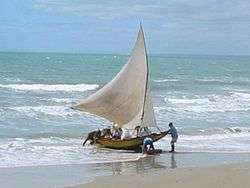Paraw


The paraw is a double outrigger sail boat native to the Visayas region of the Philippines. The paraw is similar to a proa, but the paraw has two outriggers or katig.
Etymology
The word paraw also parao is related to proa and may be used to denote a boat. However, the term for boats (with or without outriggers) in the Philippines without sails or layag are typically called vanca or bangka.
Characteristics
The paraw has three major elements that make it a paraw: the bangka, the katig and the layag. Motorized versions of bangkas (with outriggers) are commonly known as pump boats and are used for inter-island travel.
Paraws can sail between 11 and 17 knots (20~31 km/h). The outriggers (ama), or katig, are made of wood or bamboo, and may be straight or curved upward much like skis.
Construction
Traditionally these boats have been made from dungon, guisoc, ipil, duca, baslayan, obacya, bayog, Philippine mahogany (lawaan), basa and molave. Modern versions use plywood. The ropes of the boats are traditionally made from abaca (Manila hemp), but are now often synthetic rope.
The boat or canoe without outriggers is called a bangka (vanca) or baroto (also baloto) and may be dug out from solid tree trunk or made of planks secured with wooden nails. People familiar with terminology relating to the proa may recognize this as the vaka. The boat itself may be classified by passenger capacity as isahan ("for one [person]") or duwahan ("for two [persons]"), but the paraw usually has capacity for more than two people, leading to its use in ferrying small groups of passengers and goods between islands. The narrow cross-section of the boat made it sleek, cutting across water without a lot of drag.
The two katig or outriggers usually made from bamboo or various kinds of wood and served as counterpoise so that the boat would not easily overturn. They are attached to the boat via tarik (akas). The presence of the outriggers negates the need for a heavy keel and therefore reduces the overall weight of the paraw without sacrificing stability.
The layag or main sail may be made of anything from woven mats, cloth, canvas even sack cloth. Traditionally the main sail is similar to a lateen rig or a crabclaw sail and is attached to a vertical and horizontal spar, the sail differs from a traditional lateen rig in that the vertical spar is parallel to the mast and does not suffer from bad tack. The sail's spar may be as long as the mast, unattached and may appear to be longer than the mast when attached to it. There are no guidelines as to how the main sail is shaped but it may approximate an equilateral triangle. The paraw is also equipped with a foresail or jib and adds to the overall surface area and generated thrust derived from the wind. A variation of the paraw with rectangular sails is the vinta.
The mast, commonly made of bamboo, is secured by lines attached to, among other things, the outriggers, the fore (and sometimes, the aft) and various parts of the boat. Historically, the mast of smaller paraws was a spear or bangkaw and was a useful part of the ship when conducting raids against other seaside villages.
Current uses
Paraw Regatta
The Paraw Regatta a large tourism event is held annually since 1973 is a 36.5 kilometer race held in the Iloilo City.
Paraw sailing Boracay Island
Before Boracay Island became a tourist resort, paraws were used for fishing and transportation of people as well as goods. Paraw sailing these days is a major tourist attraction. Local sailors offer their paraws for Island hopping and sunset sailing for a fairly small renting fee.
See also
References
- "A Perspective of the Paraw". Iloilo Paraw Regatta. Iloilo Paraw Regatta Foundation. 2009-06-09. Retrieved 2009-06-09.
- Henry F. Funtecha, Ph.D. (February 27, 2009). "Baroto, paraw, batil, barangay, etc: Panay's maritime legacy". The News Today. The News Today. Retrieved May 21, 2010.
- Ernesto J. Laput. "Mga Barko ng Ninuno" [The Ships of (our) Ancestors]. PINAS: Munting Kasaysayan ng Pira-Pirasong Bayan (in Tagalog). elaput.org. Retrieved May 13, 2010.
External links
| Wikimedia Commons has media related to Paraw. |
- A Perspective of the Paraw, form the Iloilo Paraw Reggatta website, describes the parts of paraw and provides drawings
